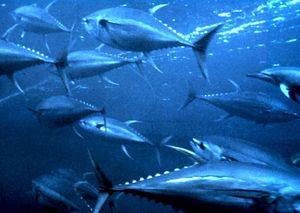While world leaders and Asian policymakers focus on disputes in the South China Sea, a less-publicized threat looms right over the horizon: over-fishing. As an important natural resource is rapidly depleted, millions, even billions, could be affected. Israeli innovation has an important role to play in averting catastrophe.
The South China Sea is one of the most important economic, military, and environmental locations on earth. Ten countries and territories surround it, and over $5.3 trillion worth of international trade traverses their shores annually. The area covers approximately 1.4 million square miles, and its rich marine ecosystem provides food and jobs to millions. Around the world, one in five people depend on fish as their primary source of protein, and over 200 million rely on fishing for their livelihood and food security. According to the UN’s Food and Agriculture Organization, however, more than 80 percent of the world’s fish species are depleted or are not producing at maximum capacity.
Seven of the 10 countries around the South China Sea claim some or all of the maritime features, which could lead to major conflagration. In early 2014, China, which claims most of the waters as sovereign territory, shifted its foreign policy, building military bases on disputed islands and systematically intimidating non-Chinese fisherman.
Political tensions and hostile naval actions have caused a destructive cycle: non-Chinese fishermen do not venture very far off their coasts, resulting in local over-fishing and illegal practices. Fishermen use underwater bombs and cyanide to optimize their catch. Chinese nationals are encouraged by their government to fish as much as possible throughout this vast ocean to flex their national muscle, further adding to over-fishing.
The South China Sea has less than one-tenth the number of fish it did 60 years ago. “What we’re looking at is potentially one of the world’s worst fisheries collapses ever,” says John McManus, a University of Miami marine ecologist. The fishing industry cannot be regulated as long as the territorial conflict continues, and it is unlikely to end anytime soon.
For years, fishermen have used fish farming, or aquaculture, to help them cope with geopolitical disputes, dwindling fish supplies, pollution, and weather. But farms bring challenges of their own. Until recently, they had to be located near the ocean because waste had to be channeled out and the fish resupplied with fresh seawater. Over time, however, waste byproducts dumped into the ocean, primarily nitrogen, made the area uninhabitable for other marine life. Consequently, many countries limited the use of fish farms or banned them entirely. But experts see fish farms as among the few technological solutions to over-fishing.
Innovators have tried building fish farms with embedded treatment systems, but until recently, all produced fish that were far more expensive than ocean-caught fish or had adverse environmental effects because of pollution.
Almost 25 years ago, Hebrew University Professor Jaap Van Rijn invented a solution: “zero-discharge” fish farming, an entirely self-contained, recirculating aquaculture system that did not emit waste. Van Rijn sought a way to treat water using biological filters and specially grown bacteria to consume fish fecal matter. Experts called it impossible.
Yet Van Rijn’s idea has inspired an innovative industry. His solution has been tested extensively and proven to work with extremely limited amounts of water, without harming the environment. Large Jacuzzi-like tanks are filled with water, and fish are added. Next, his specially created microbes, which treat the fish waste and nitrogen, are mixed in. Only evaporated water is replaced. This allows fish to grow to full maturation and remain in the tanks until they are sold or eaten. The system is efficient, yields no pollution and can be set up anywhere. No additives or potentially carcinogenic antibiotics are used. Van Rijn’s innovation provides a viable fish farm alternative without any of the harmful consequences.
Today, only about two-dozen land-based recirculating farms around the globe grow salmon, trout, and steelhead fish. A variety of governmental and non-governmental agencies have an important role to play in ensuring more ventures adopt this technology.
According to ForeignAssistance.gov, the 2017 U.S. foreign aid budget for countries around the South China Sea will be over half a billion dollars. The Trump administration should allocate a percentage for recirculating aquaculture systems for national security and ecological reasons, and for an easy public opinion win. This will boost local economies and give fishermen a powerful (and ecologically friendly) way to engage in their trade.
Last May, the U.S. National Oceanic and Atmospheric Administration (NOAA) released its 2016-2020 strategic plan, which aims to expand sustainable U.S. marine aquaculture production by at least 50 percent. The United States today imports over 90 percent of its seafood, and about half is farmed. NOAA’s strategy, however, has only one brief mention of recirculating systems, and according to industry experts, NOAA is focused on open-water aquaculture. The new NOAA administrator should focus on more sustainable production that protects consumer health and the marine environment.
International organizations like the World Bank and UN Food and Agriculture Organization have recognized the need to develop a reliable and sustainable way to secure more seafood to feed billions of people around the world. Fish farms already provide 50 percent of the world’s 167 million tons of fish, and experts believe that by 2030, another 40 million tons will be needed to meet consumer protein needs. Van Rijn’s method provides a solution that will not destroy the ocean further and will curb over-fishing.
“Aquaculture, not the Internet, represents the most promising investment opportunity of the 21st century,” according to the late Peter Drucker, economist and Nobel laureate. As the planet’s population grows, so too will the human appetite for fish protein. Policymakers around the world wishing to prevent over-fishing, protect marine life, provide healthy food, and address national security concerns should look to Israel for innovative solutions.
Avi Jorisch (@avijorisch) is a Senior Fellow at the American Foreign Policy Council and the author of a forthcoming book on Israeli innovation.
































